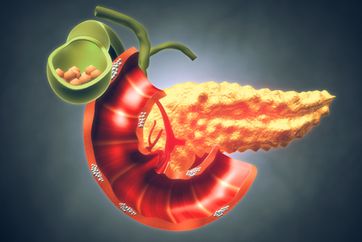Type 1 diabetes may shrink pancreas, deteriorate exocrine function in children
Children with type 1 diabetes have smaller pancreases than children without the disease, and this may adversely affect exocrine function in this population, according to findings published in Diabetic Medicine.
“Serum trypsinogen, a marker of exocrine function, is lower in adolescents and adults with type 1 diabetes, with intermediate levels in islet autoimmune subjects,” Jennifer Couper, MD, a pediatric endocrinologist at Women’s and Children’s Hospital in Adelaide, Australia, and colleagues wrote in the study introduction. “Type 1 diabetes is a heterogeneous disease. Young children who progress more rapidly to type 1 diabetes before mid-childhood may not necessarily develop these pancreatic changes.”
Couper and colleagues compared both transverse and longitudinal pancreas size of 32 children with type 1 diabetes (median age, 5.5 years; 56.3% girls) and 90 children without the condition (median age, 6.6 years; 51.1% girls). In addition, comparisons of fecal elastase-1 — which the researchers called a “noninvasive measure of exocrine function” — were made between the 32 children with type 1 diabetes and 38 children (median age, 3.6 years; 44.7% girls) who were related to someone with the condition but did not have it themselves. Participants with type 1 diabetes attended diabetes clinics of the Women’s and Children’s Hospital and were recruited consecutively, according to the researchers.

Children with type 1 diabetes had an average transverse pancreatic area of 6.82 cm2 compared with an average of 8.31 cm2 in the children without type 1 diabetes (P < .001). Children with type 1 diabetes also had smaller longitudinal pancreatic area compared with those without the condition (1.28 cm2 vs. 1.55 cm2; P = .003). In addition, the median level of fecal elastase-1 in children with type 1 diabetes was 455 µg/g compared with a mark of 1,408 µg/g in children without type 1 diabetes who were related to someone with the condition (P < .001), the researchers wrote.
“Our findings prompt the important question as to when pancreatic size and [fecal elastase-1] levels decline in young children progressing to type 1 diabetes?” the researchers wrote. “If [fecal elastase-1] levels fall before or in parallel to the fall in beta-cell function they could prove an important biomarker in the progression to type 1 diabetes.” – by Phil Neuffer
Disclosures: The authors report no relevant financial disclosures.
